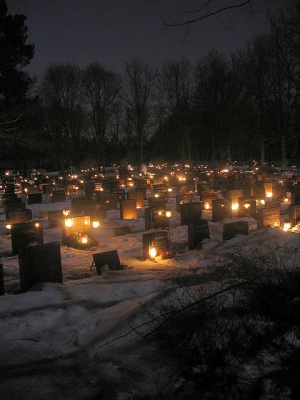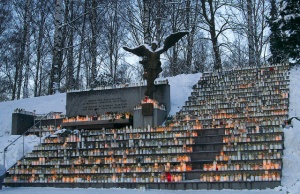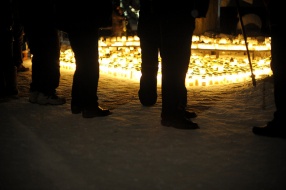Visiting cemeteries on Christmas Eve
| Visiting cemeteries on Christmas Eve | ||||
|---|---|---|---|---|
| In the national inventory | ||||
|

Practitioners and people who know the tradition well
Practitioners and experts in the tradition Bringing candles to cemeteries on Christmas Eve is a wide-spread tradition in Finland practised by families, from children and grandparents. This tradition is practised of a person’s free will and people are not separately told or encouraged to do it. On Christmas Eve, people whose relatives have passed away or people who are looking for peace and silence visit the cemetery. The Church as an organisation is linked to this tradition in as much as these events are held in cemeteries and in churches during Christmas. Guards of honour, members of the Finnish Defence Forces, stand at war graves.
Practising of the tradition
It is traditional to buy grave candles, lanterns and wreaths or other decorations made of evergreens before Christmas Eve. Some also bring flowers to the cemetery, such as heather. In the afternoon twilight of Christmas Eve, families dress up warmly, take their candles and decorations with them and go to the cemetery. Often, when arriving there, the group is in a prayerful state of mind, and together they walk to the graves of their loved ones. They often visit the graves in an established order or by the best route. Decorations and candles are placed by each grave, after which the family members take a quiet moment to think about the person who has passed away, either silently or by saying a few words aloud, whichever they prefer. Some people also visit the war graves to pay their respects to the people lost in wars. If a family’s loved one has been buried somewhere else, they can also take a candle to a memorial for people buried in other places. Many families try to visit the cemetery later in the day, often before the Christmas dinner. This may be because of the different atmosphere in cemeteries after dark. It is easy to see how wide-spread this tradition is every Christmas Eve; for example, the entire cemetery of Hietaniemi in Helsinki is lit up by a sea of candles.
The background and history of the tradition

In Finland, the deceased are primarily remembered at Christmas. Visiting graves and lighting grave candles is an old, pagan tradition. As kekri, the Finnish harvest festival, started to lose its significance, its traditions of placating and feasting to honour the dead moved to Christmas. When Christianity came to Finland, the so-called services for the departed became a part of Finnish Christmas traditions, unlike other countries, who remember their dead on All Saints' Day.
In Lutheran cemeteries, the first candles appeared in early 1920s; the earliest documented occurrence of the tradition is from Helsinki’s Old Cemetery from 1921. On Christmas Eve, secondary school graduate Lyyli Grotenfelt, daughter of Professor Kustavi Grotenfelt, lit a candle on the grave of her late sister Kyllikki, who had died earlier that year, on 20 September. The habit started to spread little by little, and after the wars lighting candles on graves rapidly became more common. Today, thousands of candles illuminate Finnish cemeteries on the night of Christmas Eve, especially the War Graves. The tradition was probably adopted from the Germanic Moravian Church.
The habit spread after the wars, first at war graves but soon after also on other graves. Maybe this is a remnant of the old worship of ancestors, as the Finns are faithful practitioners of this tradition today. In other Nordic countries, this tradition has apparently not spread as widely. In Sweden in the 1890s, there were occurrences in the larger cities where people set up small fir trees with candles on graves during Christmas. According to some estimates, the tradition may originate from the Germanic Moravian Church. In Roman Catholic countries, candles on graves are mostly lit on All Saint’s Day. In Finland, Christmas Eve is a more popular time for grave candles than All Saint’s Day. The tradition has changed due to factors such as improved traffic connections. In the era before cars, people used to ride to cemeteries in horse-drawn carriages, especially in rural areas. Also, before, normal candles were used as grave candles, but nowadays the candles as specifically made for the purpose: they burn for significantly longer and have a plastic cover that helps the candle stay aflame.

The transmission of the tradition
The tradition is passed on from one generation to another through practising it together and telling others about it. As visiting the cemetery is a tradition for the entire family, it is being passed on naturally every Christmas and its significance is not usually questioned. Visiting the cemetery and lighting candles on Christmas Eve becomes a familiar part of Christmas in many families over the years. The tradition has been widely recorded in writings. The radio and other media spread information about the tradition. In part, this visibility helps reinforce the tradition and pass it on. This way, the tradition is passed on in a slightly different way than before.
The future of the tradition
The tradition of bringing candles to place on graves on Christmas Eve remains strong. It brings people together and creates an emotional and visual Christmas experience. It seems that even the younger generation needs these kinds of traditions in this quickly changing, uncertain world. The tradition has also affected the rest of society. Congregations, for example, have reacted to people’s habit of bringing candles to place on graves on Christmas Eve by cleaning away rubbish from cemeteries after Christmas. Candle sales increase around Christmas. In addition to this, the public transport company HSL in Helsinki, and potentially others too, arranges extra buses to the cemetery at Christmas.
The community behind this submission
Ritva Lassila, Julia Isoniemi, Terhi Lassila, Anna Koponen, Tiina Tuononen, Sirke Kotonen, Marjatta Riikonen, Inkeri Leikkonen, Tiina Koponen, Tommi Lassila, Marja Rosenberg, Anniina Seppälä, Salla Mustonen, Pirjo Launonen, Sari Salo, Taina Juva, Sanna Jantunen, Alice Karlsson, Eija Lassila, Sannamaija Marttinen, Riitta Taipale, Riitta-Maija Kurri, Virpi Kalliokuusi, Heli Keijonen, Päivi Tuuri, Robert Frost
Bibliography and links to information
Websources
Christmas Eve in a candlelit cemetery - thisisFINLAND
"Kyntillät syttyvät haudoilla" on jouluviettomme aikamerkki (YLE Eävä arkisto 16.12.2013) Sisältää useita radio-ohjelmia aiheesta.
Kynttilät syttyvät jouluaattona haudoilla – "Hautausmaalla saa myös laulaa" (YLE Uutiset 23.12.2016)
Kunniavartiossa karskilla miehellä voi tulla tippa linssiin. (YLE Uutiset 13.5.2015)
Litterature
Aurejärvi-Karjalainen, Anneli 1999: Perheen omat juhlat: Siviiliseremoniat häistä hautajaisiin. Porvoo Helsinki Juva: WSOY.
Karjalainen, Sirpa; Silvennoinen, Maija; Kuosmanen, Riitta-Liisa & Opas, Hilkka (toim.) 1997: Joulu Kultainen. Weilin+Göös.
Karjalainen, Sirpa; Korhonen, Seppo; Lehtonen, J.U.E 1989: Uusi ajantieto. Porvoo.
Vilkuna, Kaisa 1973: Vuotuinen ajantieto. Keuruu.
Vuolio, Kaisu 1981: Suomalainen joulu. WSOY.
Vuolio (Jaakkola), Kaisu 1977: Muuttuva joulu: kansatieteellinen tutkimus. Suomen muinaismuistoyhdistys.
Helsingin Sanomat 18.11.2007: Kirstin palsta
